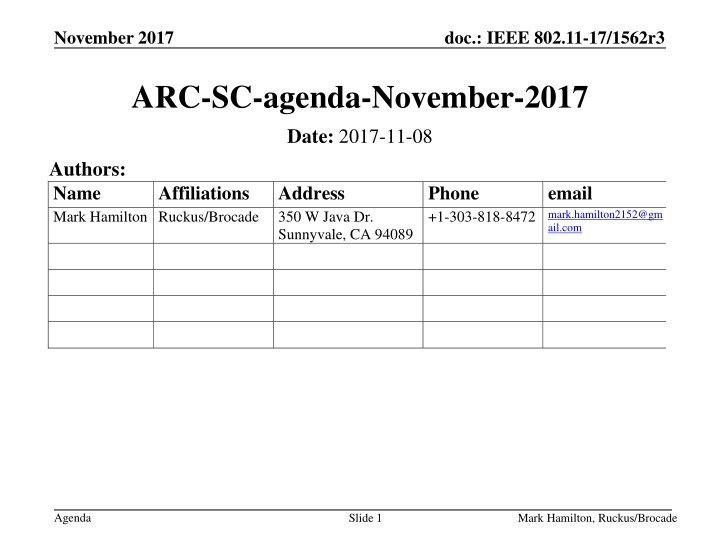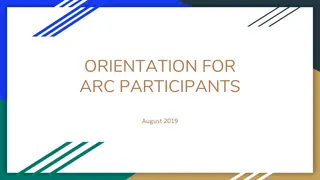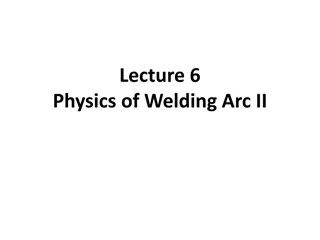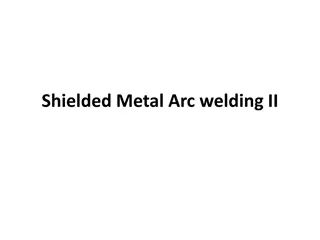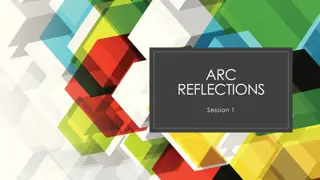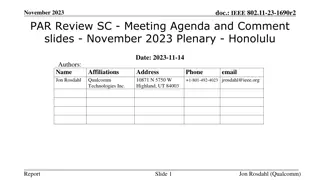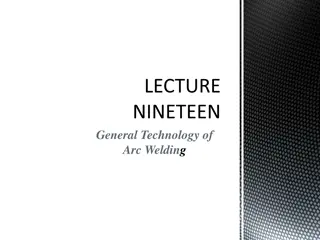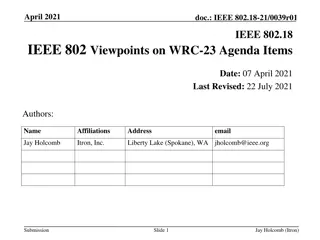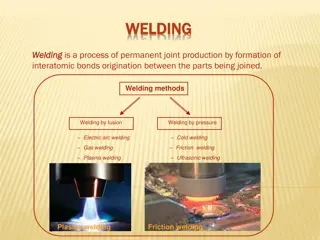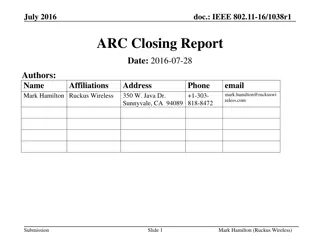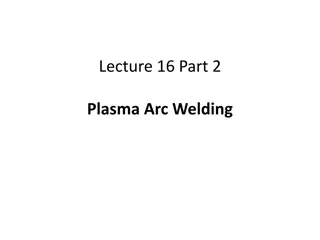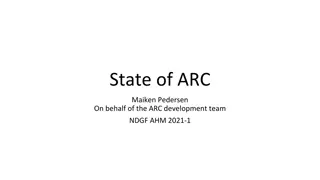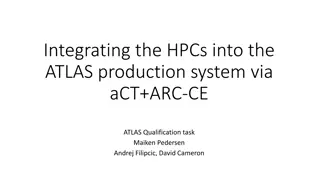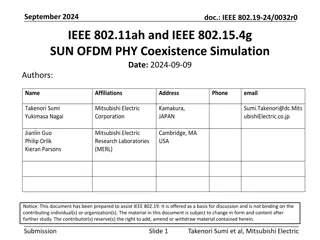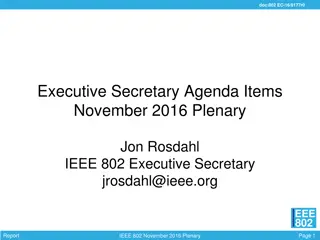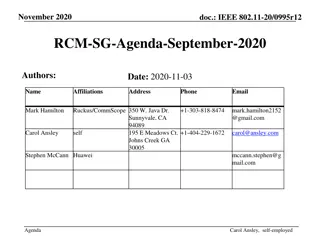IEEE 802.11-17/1562r3 ARC-SC Agenda, November 2017
Agenda for the IEEE 802.11 Architecture Standing Committee meeting held in November 2017, chaired by Mark Hamilton from Ruckus/Brocade. The agenda includes details on participants' obligations under the IEEE-SA Patent Policy, attendance guidelines, and related patent policy links for all attendees.
Download Presentation

Please find below an Image/Link to download the presentation.
The content on the website is provided AS IS for your information and personal use only. It may not be sold, licensed, or shared on other websites without obtaining consent from the author.If you encounter any issues during the download, it is possible that the publisher has removed the file from their server.
You are allowed to download the files provided on this website for personal or commercial use, subject to the condition that they are used lawfully. All files are the property of their respective owners.
The content on the website is provided AS IS for your information and personal use only. It may not be sold, licensed, or shared on other websites without obtaining consent from the author.
E N D
Presentation Transcript
November 2017 doc.: IEEE 802.11-17/1562r3 ARC-SC-agenda-November-2017 Date: 2017-11-08 Authors: Name Mark Hamilton Ruckus/Brocade Affiliations Address 350 W Java Dr. Sunnyvale, CA 94089 Phone +1-303-818-8472 mark.hamilton2152@gm email ail.com Agenda Slide 1 Mark Hamilton, Ruckus/Brocade
November 2017 doc.: IEEE 802.11-17/1562r3 Abstract Agenda for: ARC SC, November 2017, Orlando, Florida, USA Agenda Slide 2 Mark Hamilton, Ruckus/Brocade
November 2017 doc.: IEEE 802.11-17/1562r3 IEEE 802.11 Architecture Standing Committee Agenda November 2017 session Chair: Mark Hamilton (Ruckus/Brocade) Vice Chair: Joe Levy (InterDigital) Agenda Slide 3 Mark Hamilton, Ruckus/Brocade
November 2017 doc.: IEEE 802.11-17/1562r3 Tuesday, November 7th, AM2 Agenda Slide 4 Mark Hamilton, Ruckus/Brocade
November 2017 doc.: IEEE 802.11-17/1562r3 Attendance, etc. Reminders to attendees: Sign in for .11 attendance credit Noises off No recordings Agenda Slide 5 Mark Hamilton, Ruckus/Brocade
November 2017 Participants, Patents, and Duty to Inform doc.: IEEE 802.11-17/1562r3 All participants in this meeting have certain obligations under the IEEE-SA Patent Policy. Participants [Note: Quoted text excerpted from IEEE-SA Standards Board Bylaws subclause 6.2]: Shall inform the IEEE (or cause the IEEE to be informed) of the identity of each holder of any potential Essential Patent Claims of which they are personally aware if the claims are owned or controlled by the participant or the entity the participant is from, employed by, or otherwise represents Should inform the IEEE (or cause the IEEE to be informed) of the identity of any other holders of potential Essential Patent Claims (that is, third parties that are not affiliated with the participant, with the participant s employer, or with anyone else that the participant is from or otherwise represents) The above does not apply if the patent claim is already the subject of an Accepted Letter of Assurance that applies to the proposed standard(s) under consideration by this group Early identification of holders of potential Essential Patent Claims is strongly encouraged No duty to perform a patent search Agenda Slide 6 Mark Hamilton, Ruckus/Brocade
November 2017 doc.: IEEE 802.11-17/1562r3 Patent Related Links All participants should be familiar with their obligations under the IEEE-SA Policies & Procedures for standards development. Patent Policy is stated in these sources: IEEE-SA Standards Boards Bylaws http://standards.ieee.org/develop/policies/bylaws/sect6-7.html#6 IEEE-SA Standards Board Operations Manual http://standards.ieee.org/develop/policies/opman/sect6.html#6.3 Material about the patent policy is available at http://standards.ieee.org/about/sasb/patcom/materials.html If you have questions, contact the IEEE-SA Standards Board Patent Committee Administrator at patcom@ieee.org or visit http://standards.ieee.org/about/sasb/patcom/index.html This slide set is available at https://development.standards.ieee.org/myproject/Public/mytools/mob/slideset.ppt Agenda Slide 7 Mark Hamilton, Ruckus/Brocade
November 2017 doc.: IEEE 802.11-17/1562r3 Call for Potentially Essential Patents If anyone in this meeting is personally aware of the holder of any patent claims that are potentially essential to implementation of the proposed standard(s) under consideration by this group and that are not already the subject of an Accepted Letter of Assurance: Either speak up now or Provide the chair of this group with the identity of the holder(s) of any and all such claims as soon as possible or Cause an LOA to be submitted Agenda Slide 8 Mark Hamilton, Ruckus/Brocade
November 2017 doc.: IEEE 802.11-17/1562r3 Participation in IEEE 802 Meetings Participation in any IEEE 802 meeting (Sponsor, Sponsor subgroup, Working Group, Working Group subgroup, etc.) is on an individual basis Participants in the IEEE standards development individual process shall act based on their qualifications and experience. (https://standards.ieee.org/develop/policies/bylaws/sb_bylaws.pdf section 5.2.1) IEEE 802 Working Group membership is by individual; Working Group members shall participate in the consensus process in a manner consistent with their professional expert opinion as individuals, and not as organizational representatives . (subclause 4.2.1 Establishment , of the IEEE 802 LMSC Working Group Policies and Procedures) Participants have an obligation to act and vote as an individual and not under the direction of any other individual or group. A Participant s obligation to act and vote as an individual applies in all cases, regardless of any external commitments, agreements, contracts, or orders. Participants shall not direct the actions or votes of any other member of an IEEE 802 Working Group or retaliate against any other member for their actions or votes within IEEE 802 Working Group meetings, see https://standards.ieee.org/develop/policies/bylaws/sb_bylaws.pdf section 5.2.1.3 and the IEEE 802 LMSC Working Group Policies and Procedures, subclause 3.4.1 Chair , list item x. By participating in IEEE 802 meetings, you accept these requirements. If you do not agree to these policies then you shall not participate. (Latest revision of IEEE 802 LMSC Working Group Policies and Procedures: http://www.ieee802.org/devdocs.shtml) Agenda Slide 9 Mark Hamilton, Ruckus/Brocade
November 2017 doc.: IEEE 802.11-17/1562r3 Other Guidelines for IEEE WG Meetings All IEEE-SA standards meetings shall be conducted in compliance with all applicable laws, including antitrust and competition laws. Don t discuss the interpretation, validity, or essentiality of patents/patent claims. Don t discuss specific license rates, terms, or conditions. Relative costs, including licensing costs of essential patent claims, of different technical approaches may be discussed in standards development meetings. Technical considerations remain primary focus Don t discuss or engage in the fixing of product prices, allocation of customers, or division of sales markets. Don t discuss the status or substance of ongoing or threatened litigation. Don t be silent if inappropriate topics are discussed do formally object. --------------------------------------------------------------- See IEEE-SA Standards Board Operations Manual, clause 5.3.10 and Promoting Competition and Innovation: What You Need to Know about the IEEE Standards Association's Antitrust and Competition Policy for more details. Agenda Slide 10 Mark Hamilton, Ruckus/Brocade
November 2017 doc.: IEEE 802.11-17/1562r3 ARC Agenda November 2017 Tuesday, November 7, AM2 Administrative: Minutes IEEE 1588 mapping to IEEE 802.11/802.1ASrev use of FTM update - 11-17/1086r4 802 (and 802.1) activities IETF/802 coordination Investigation of WUR architecture topics; may lead into split PHYs (LC, 28 GHz (Phazr)): 11-17/1025r0 MIB attributes Design Pattern - 11-15/0355r8, 11-17/0475r8, 11-14/1281r4, 11-09/0533r1 YANG/NETCONF modeling discussions 11-16/1436r1 AP/DS/Portal architecture and 802 and GLK concepts - 11-17/0136r2, 11-16/1512r0, 11- 16/0720r0, 11-15/0454r0, 11-14/1213r1 (slides 9-11) What is an ESS? Tuesday, November 7, PM2 Continue the above Wednesday, November 8, AM1 Continue the above Future sessions / SC activities Agenda Slide 11 Mark Hamilton, Ruckus/Brocade
November 2017 doc.: IEEE 802.11-17/1562r3 ARC Minutes September face-to-face minutes: 11-17/1483r0 August 1 teleconference minutes: 11-17/1752r0 Agenda Slide 12 Mark Hamilton, Ruckus/Brocade
November 2017 IEEE 1588 mapping to IEEE 802.11/ 802.1ASrev use of FTM update doc.: IEEE 802.11-17/1562r3 Update (Mark Hamilton) IEEE 1588 D1.2 Completed Working Group ballot (Note their process is a little different) 1504 comments 802.1AS D5.0 In Working Group ballot resolution (since July) 802.1AS use of 802.11 FTM: 11-17/1086r4 (Ganesh Venkatesan) Agenda Slide 13 Mark Hamilton, Ruckus/Brocade
November 2017 IEEE 802 activities directly related to IEEE 802.11 ARC doc.: IEEE 802.11-17/1562r3 Update (Mark Hamilton) 802.1Q revision underway, D2.0 Sponsor ballot closed Oct 7. 73 Approve (93%); 5 Disapprove (7%); 8 Abstain 56 comments. Recirc before Jan. Roll-in: IEEE Std 802.1Qcd-2015, IEEE Std 802.1Qca-2015, IEEE Std 802.1Q-2014 Cor 1-2015, IEEE Std 802.1Qbv-2015, IEEE Std 802.1Qbu-2016, IEEE Std 802.1Qbz-2016 802.1AC-2016 published Add Roll-in: IEEE Std 802.1Qci-2017, IEEE Std 802.1Qch-2017 Agenda Slide 14 Mark Hamilton, Ruckus/Brocade
November 2017 doc.: IEEE 802.11-17/1562r3 IETF/802 coordination Dorothy Stanley present topics of interest: None, this time Agenda Slide 15 Mark Hamilton, Ruckus/Brocade
November 2017 doc.: IEEE 802.11-17/1562r3 TGba architecture topics Investigation of TGba (WUR) architecture topics may lead into discussion of other split PHYs (LC, 28 GHz (Phazr)) Presentations: 11-17/1025r0 Also see following slides TGba is still maturing, through the SFD process. Target January session to continue substantive discussions (?) Agenda Slide 16 Mark Hamilton, Ruckus/Brocade
November 2017 TGba architecture comments/answers to questions in 11-17/1025 (from Mon AM1) Yes, fully independent PHY Probably independent MAC? Always co-located with AP or non-AP STA a companion radio No MAC Address (?) WUR MAC (assuming it is independent) does need to coordinate with the main MAC. Main MAC negotiates a WUR ID on WUR s behalf, for example. And, power on/off needs to be coordinated between them might be through higher layer entity, though (?) WUR does not associate to the BSS (it doesn t have a MAC Address) WUR only runs in 2.4/5 GHz. But, can work with all PHYs (maybe?) Mesh, IBSS, OCB uses are TBD in the future, not now doc.: IEEE 802.11-17/1562r3 Agenda Slide 17 Mark Hamilton, Ruckus/Brocade
November 2017 TGba architecture new questions (from Wed AM1 ARC) Does every WUR stack have an individual ID ( WUR address )? Or, could a given WUR stack be only addressed using a group ID in some scenarios? How are WUR ID s made globally unique, or are they? What about overlapping WUR coverage? Prevented using the same solution as security protections? Prevented through selection of different sub-carriers? How does the WUR stack become aware of ongoing NAV protections? RX doesn t need to know. What about the TXr? For protection how much of a legacy frame header is sent? Just PHY header? Some MAC header (addresses? NAV? Etc) Is there any sharing (necessarily, as part of the design, not implementation choice) of RF front-end? What happens when the Main stack wakes up? Does it still have an association? Is it in some power save state (which)? Yes, fully independent PHY is that for the RX side, or the TX side? What about error recovery? STA goes out of range? What if the AP changes (DFS, ITS, etc)? doc.: IEEE 802.11-17/1562r3 Agenda Slide 18 Mark Hamilton, Ruckus/Brocade
November 2017 TGba architecture potential assumptions (from Wed AM1 ARC) How does the WUR stack become aware of ongoing NAV protections? RX doesn t need to know. The master s Main stack runs the usual medium access, and wait until it has a TXop, then triggers the WUR to TX. On the RXr, only one stack (WUR or Main) are active at a given point in time. When the Main stack wakes up, it still has an association and is in a power save state (a new WUR power save state). The Main stack TXs, which is the indication that the wakeup was successful and completed. There are 100% RX WURs, at the sleeping node. There are TXrs, on the master node, and these are therefore (potentially) different architecturally. The WUR wakeup frame does not NAV protect to cover the sleeping device s Main radio waking up and TXing. doc.: IEEE 802.11-17/1562r3 Review 11-17/972 to confirm/before proceeding on the above Agenda Slide 19 Mark Hamilton, Ruckus/Brocade
November 2017 doc.: IEEE 802.11-17/1562r3 Discussion on YANG/NETCONF models We have a likely window now to make a change, if any, as we transition from REVmc to REVmd maintenance activities Submissions: https://mentor.ieee.org/802.11/dcn/16/11-16-1436-00-0arc-yang-modelling-and- netconf-protocol-discussion.pptx Agenda Slide 20 Mark Hamilton, Ruckus/Brocade
November 2017 doc.: IEEE 802.11-17/1562r3 AP/DS/Portal architecture and 802 concepts Presentations on architectural description(s) https://mentor.ieee.org/802.11/dcn/17/11-17-0136-02-0arc-bridging-architecture- considerations.docx Reference presentations (previously reviewed, current status of thinking): https://mentor.ieee.org/802.11/dcn/14/11-14-1213-01-0arc-ap-arch-concepts-and- distribution-system-access.pptx https://mentor.ieee.org/802.11/dcn/13/11-13-0115-15-0arc-considerations-on-ap- architectural-models.doc https://mentor.ieee.org/802.11/dcn/14/11-14-0497-03-0arc-802-11-portal-and-802- 1ac-convergence-function.pptx https://mentor.ieee.org/802.11/dcn/14/11-14-0562-05-00ak-802-11ak-and-802-1ac- convergence-function.pptx https://mentor.ieee.org/802.11/dcn/15/11-15-0454-00-0arc-some-more-ds- architecture-concepts.pptx https://mentor.ieee.org/802.11/dcn/16/11-16-0720-00-0arc-stacked-architecture- discussion.pptx Agenda Slide 21 Mark Hamilton, Ruckus/Brocade
November 2017 doc.: IEEE 802.11-17/1562r3 What is an ESS? Current definition depends on the relationship to LLC A set of one or more interconnected basic service sets (BSSs) that appears as a single BSS to the logical link control (LLC) layer at any station (STA) associated with one of those BSSs. That would mean a 802.1 Bridged LAN (for example) creates an ESS. Probably not what we (802.11) meant. We probably meant something about transparency of location of attachment / mobility , from whatever is using the 802.11 MAC and other entities, necessary to accomplish this? ESS == demarcation of this transparency?? Is it: Transparent to whatever upper layer is above 802.11? Includes entities beyond (above?) 802.11? (Like bridges in the 11ak scenario?) The APs have to have some common/similar configuration settings? (SSID, at least. Probably other facilities (security, etc.) and policies?) Changes to Figure 4-1: BSS s are just STAs. These ovals are BSAs. Also, should we be saying OBSA ? Agenda Slide 22 Mark Hamilton, Ruckus/Brocade
November 2017 doc.: IEEE 802.11-17/1562r3 What is an ESS? (Continued) Current definition depends on the relationship to LLC A set of one or more interconnected basic service sets (BSSs) that appears as a single BSS to the logical link control (LLC) layer at any station (STA) associated with one of those BSSs. We probably meant something about transparency of location of attachment / mobility , from whatever is using the 802.11 MAC 802 Services includes other entities, necessary to accomplish this? (EAP Auth Service? Bridges (11ak)? ANQP, etc?) ESS boundary == demarcation of this transparency?? Yes, + common domain of mobility that works, including security, policy, etc., necessary for mobility that actually works. Is it: Transparent to whatever upper layer is above 802.11? No, boundary may be higher than that Includes entities beyond (above?) 802.11? (Like bridges in the 11ak scenario?) Yes, as needed The APs have to have some common/similar configuration settings? (SSID, at least. Probably other facilities (security, etc.) and policies?) Yes. Changes to Figure 4-1: BSS s are just STAs. These ovals are BSAs. Also, should we be saying OBSA ? Agenda Slide 23 Mark Hamilton, Ruckus/Brocade
November 2017 doc.: IEEE 802.11-17/1562r3 What is an ESS? Direction? Straw proposal - ESS is: [Edit this list, per discussion] Set of one of more basic services sets (BSSs) Appears as a single logical network, to layers above the ESS boundary The boundary might be above 802 (above Layer 2), or might be within Layer 2 (the MAC SAP, etc.) The boundary must exist/be clear for participating end stations (see 802 O&A), and external devices that can interwork with the participating end stations Provides transparency of location of attachment / mobility , as seen by layers above the ESS boundary, on both participating end stations and external end stations. Includes all entities necessary to provide the services and transparency required. Has a common domain of mobility and a common security and policies and configuration necessary to deliver the transparency from mobility. Agenda Slide 24 Mark Hamilton, Ruckus/Brocade
November 2017 doc.: IEEE 802.11-17/1562r3 Tuesday, November 7th, PM2 Agenda Slide 25 Mark Hamilton, Ruckus/Brocade
November 2017 doc.: IEEE 802.11-17/1562r3 Design Pattern for MIB attributes The WG11 Chair has requested that the ARC SC investigate and create a Design Pattern for MIB attributes of the form *Implemented and *Activated https://mentor.ieee.org/802.11/dcn/15/11-15-0355-09- 0arc-mib-truthvalue-usage-patterns.docx https://mentor.ieee.org/802.11/dcn/17/11-17-0475-08- 0arc-mib-pattern-analysis.xlsx Background: https://mentor.ieee.org/802.11/dcn/14/11-14-1068-00-0arc-mib-attributes-design- pattern-background.docx https://mentor.ieee.org/802.11/dcn/14/11-14-1281-04-0arc-mib-attributes- analysis.docx Agenda Slide 26 Mark Hamilton, Ruckus/Brocade
November 2017 doc.: IEEE 802.11-17/1562r3 Wednesday, November 8th, AM1 Agenda Slide 27 Mark Hamilton, Ruckus/Brocade
November 2017 doc.: IEEE 802.11-17/1562r3 Design Pattern for MIB attributes The WG11 Chair has requested that the ARC SC investigate and create a Design Pattern for MIB attributes of the form *Implemented and *Activated https://mentor.ieee.org/802.11/dcn/15/11-15-0355-11- 0arc-mib-truthvalue-usage-patterns.docx https://mentor.ieee.org/802.11/dcn/17/11-17-0475-09- 0arc-mib-pattern-analysis.xlsx Background: https://mentor.ieee.org/802.11/dcn/14/11-14-1068-00-0arc-mib-attributes-design- pattern-background.docx https://mentor.ieee.org/802.11/dcn/14/11-14-1281-04-0arc-mib-attributes- analysis.docx Agenda Slide 28 Mark Hamilton, Ruckus/Brocade
November 2017 doc.: IEEE 802.11-17/1562r3 ARC Future Activities & sessions ARC SC meets when a specific focused task is requested of the SC for which the is sufficient volunteer interest. Continue work on architectural models, and liaison with TGs in development of their architecture as appropriate Design Pattern for *Implemented and *Activated MIB attributes Impacts of YANG/NETCONF decision? Consider YANG/NETCONF Investigation of WUR architecture topics; may lead into split PHYs (LC, 28 GHz (Phazr)) Will also follow 802.1/802.11 activities on links, bridging, and MAC Service definition What is an ESS? , for example Monitor/report on IETF/802 activities, as needed Monitor/report on IEEE 1588 activities and 802.1ASrev use of FTM, as needed If you have ANY other topic that you would like ARC SC to consider, Agenda contact the SC chair. Slide 29 Mark Hamilton, Ruckus/Brocade
November 2017 doc.: IEEE 802.11-17/1562r3 Planning for January 2018 Plan for three individual meeting slots Usual slot on Wed AM1 Another 2 slots for standalone ARC work (Monday/Tuesday?) Plus Joint sessions: TGba? Individuals interested in ARC work are encouraged to also attend AANI SC sessions Teleconferences: Schedule with 10 days notice Agenda Slide 30 Mark Hamilton, Ruckus/Brocade
